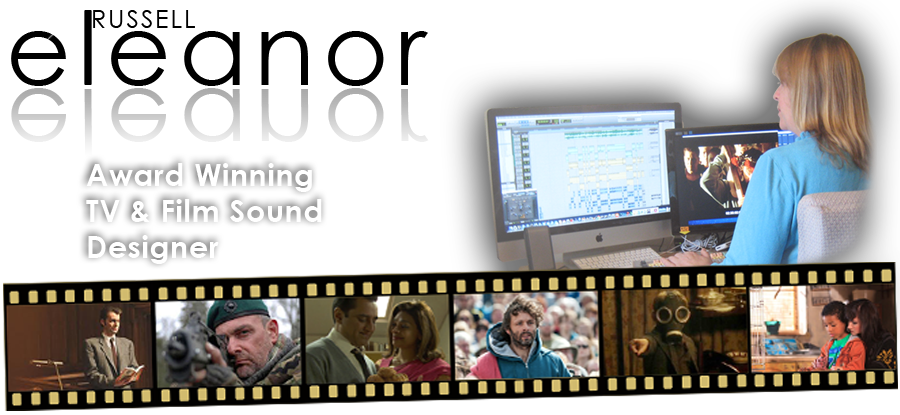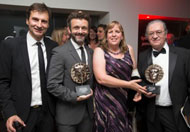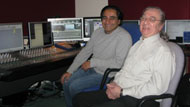
Contact Ellie Russell Film and Television Sound Design and Sound Editing
To discuss your Film or Television sound design and editing or any other Audio Post Production project please contact
Contact Ellie Russell,
Film and Television Sound Designer and Sound Editor
![]()
Iberico Ltd.
M: 07766 312049
P: 01446 710020
E: Email Ellie

Ellie Russell; Professional Film and Television Sound Design and Sound Editing Services
Providing creative and original sound tracks; ensuring that the client's vision for their film or TV project is captured and fulfilled.
Whether your project is large or small, serious or 'other-worldly' I can enhance realism through the thoughtful use of effects, or, fire the imagination and transport you to another world through creative sound design.
Working from my own sound suite means I can provide cost-effective audio post-production to fit your budget whether you are in Cardiff , Carlisle, Lisbon or London.
Although some projects may only require the original tracks to be 'tidied up' and a few effects added with stereo atmospheres, other projects may require a full track-lay and sound design. I am happy to advise clients on the audio post production that would be appropriate for their film.
I currently operate from my fully equipped Protools suite near Cardiff in South Wales or can work as a freelance at other facilities when required. Through the use of cloud storage such as Drop box, High-tail or Gobbler, projects and cutting copys can be transported easily and safely from almost any cutting room in the world to my sound-editing suite in Wales. Spotting sessions can take place at a location of your choice in the UK.
I can provide introductions to professional editing and dubbing facilities here in Wales as well as post-sync and voice over recording facilities if required. Feel free to contact me with any questions you may have on 01446 710020 or 0766 312049.
Tell me what you envisage and I will create it
It helps for me to have a copy of the script and to meet with the director at an early stage in the project to gain an insight into the feel and scope of the film to find out what he or she envisages for the soundscape. Liaising with the sound recordist, film editor and dubbing mixer prior to track-lay ensures smooth continuity and hand-over throughout the audio postproduction process.
For major projects such as feature films a team of sound editors and designers may be needed which will be provided and supervised by me. In this scenario the project is generally split up into various sections as outlined below.
Sound Editor or Sound Designer?
There is often confusion about the terms 'sound editor' and 'sound designer' so below is my definition of the two terms:
Sound Editing:
The art of editing and smoothing original recorded tracks with the addition of mono and stereo sound effects and music to create a realistic and finished sound track.
Sound design:
Sound design is the art of making and/or manipulating audio to create unique sound effects in order to create illusion or enhance realism within a film, play or video game. The project's brief may require the creation of a special soundscape for the background atmosphere, or a unique sound for an object, creature or machine. This includes the creation of special sound 'spot' effects such as larger than life explosions, gunshots or robot machines. These effects may require the recording, melding and/or the morphing of more than one sound together by the sound designer to obtain a desired effect.
Find out what a full track-lay entails…
A full track-lay may consist of over one hundred tracks of sound. For the dubbing mixer to handle so many tracks, the audio post-production track-lay is divided into sections. Each section can then be pre-mixed into stems using automation that can be updated by the dubbing mixer during the mix thus giving the dubbing mixer flexibility for the final mix.
Dubbing editors and mixers usually have to work to off-line pictures that, in an ideal world, should be locked off but this is not always the case. With a busy post-production schedule the need to accommodate picture changes from a re-edit in an efficient way may be required. For every picture edit there may be hundreds of audio edits at that point. The advent of modern audio post-production software now enables any picture re-edits post or during track-lay to be re-conformed easily and quickly.
It is helpful for the dubbing mixer to work to finished graded pictures as soon as they are available to check sync, because picture manipulation such as film effect or special effects can create extra frames or half frames which will alter the length of the film thereby putting the audio out of sync.
Dialogue edit:
The aim of the dialogue editor is to produce clear audible dialogue for the film by smoothing out transitions, removing unwanted sounds, recording extra lines where needed and replacing inaudible dialogue when necessary.
The dialogue editor utilises the original production sound that often consists of multiple tracks from different microphones and wild lines which have been shot on location. The best and most appropriate track for the camera angle is chosen and the 'ins' and 'outs' are smoothed out so that transitions are as inaudible as possible. Noise reduction is used to clean up unwanted background sound when necessary.
Dialogue is always 'placed' in the centre speaker, although in certain circumstances an out of vision piece of dialogue may need to be audible from the left, right or rear speakers.
If a line of production dialogue is unintelligible, an alternative will be sought amongst the other takes, and if no alternative is available, the line will be marked up for re-voicing. When a line of dialogue has had to be replaced by an alternative or through post sync, the original track is kept so that the director can make an informed decision over which version to use. The end result will be clear, audible dialogue tracks ready for mixing.
Post-sync, ADR or re-recording sessions:
When lines on dialogue need to be replaced or extra lines added, a post-sync session would need to be organised at a studio of your choice or at a 'partner' studio here in South Wales. The dialogue editor can produce post-sync scripts to time-code and will conduct the session if required. Post-sync recorded lines will be laid up and pulled into sync. The original lines will be kept for comparison.
Unscripted or extra shouts, crowd reactions or off-camera lines should be recorded in these sessions and laid up by the dialogue editor.
Effects Edit:
The effects are generally split into three or four sections:
Sync effects:
These tracks contain production effects with no dialogue and the dialogue editor will lay these effects on separate tracks from the dialogue so they can be used in the M & E (see below).
Atmosphere or background tracks:
These tracks are mostly stereo but can be 5:1 or 7:1 etc. and provide a blanket of background sound that will help convey realism, mood, location, time of year and time of day. These tracks generally run for the full length of each scene thus helping to bed the mono dialogue in for a seamless, realistic sound. Background or 'atmos' tracks may include general countryside tracks, distant traffic, room atmospheres or wind effects. Films, which will be mixed in surround sound, need a 'presence' of background sound in the surround speakers, which provides the listener with a fuller audio experience.
Stereo 'spot' effects are generally shorter effects that are laid on separate tracks to the background tracks. These include effects such as distant train passes, bird tracks, fire effects, crowd tracks without any discernible lines of dialogue or special sound design effects such as whooshes or hums. Specially designed effects are likely to be laid on these tracks. Special effects may also be in 5:1 etc.
Mono 'spot' effects tend to be short, close effects such as: a door closing, gun shots, dog barks, close car passes, telephone rings etc. Mono tracks can be 'panned' off to the left or right speakers or into the surround speakers to create realism or to stand out from the dialogue, effects such as car passes can be panned across the screen to picture.
Foley and footstep tracks consist of effects usually recorded in a studio using foley artistes. Foley artistes will reproduce any 'footsteps' and 'spot effects' required. Any 'footsteps' and 'spot effects' to be recorded are charted by the foley editor so that the foley recordist will know what needs to be recorded.
The foley artistes use different surfaces and props to reproduce the sounds needed and work to picture to provide recordings as close to sync as possible. Special effects needed for the film may be recorded in this session. After the recording session the Foley editor will pull these recorded tracks into perfect sync.
If a music and effects track (M & E - see below) is required for foreign sales then every single footstep and effect which is under dialogue will need to be reproduced.
A moves track is usually recorded in the same session. This is a recording of cloth moves in sync with the human actions within the film. This track helps give a presence to post-sync dialogue and is necessary for the M & E tracks.
M & E tracks:
The 'deliverables' list the versions and elements of the film required by the commissioning company. These 'deliverables' need to be created and delivered to fulfil the contract. Version requirements for foreign sales normally demand that an M and E (music and effects) track must be available. This means the provision of a separate mixed effects track and separate mixed music track with no dialogue to be included. Original production effects from the sync effects tracks will be used where possible but the M & E will undoubtedly require the re-creation of all effects and moves that are underneath dialogue. The creation of M & E tracks means that the film can be over-dubbed in another language while retaining a full effects track as close to the original as possible.
Premix Mix
The dubbing mixer will take the track-lay and, on a large project, create pre-mixes of the separate sound elements within the film. There may be over sixteen tracks within each element - backgrounds, spot effects, Foley etc. These elements need to be level-corrected separately using automation which allows the dubbing mixer to update levels, 'eq's and effects at any time during the final mix. These automated tracks are grouped into a few (often four) stems per element. This will mean that during the final mix the dubbing mixer has already balanced the tracks against the dialogue track. The pre-mixes are usually split into a background or atmos pre-mix, a dialogue premix that will include post-sync, and a spot effects pre-mix. The music is then balanced against these premixes ready for the final mix.
Final Mix
This is where the premixed tracks and music are all brought together and 'fine-tuned'. At this point the director can make his final decisions about levels and use of effects.
It is beneficial to mix to final graded pictures and is a necessity for a Dolby Digital theatrical production as when special effects are added to a film they can affect sync by adding frames or half frames to the length of the film thus putting the final mix out of sync.
At this stage in the process it is important that sync is checked against the final picture that includes all titles. The dubbing mixer will then produce the required tracks for layback to picture or optical disc.
M & E Mix
The dubbing mixer will remove the dialogue track. The pre-mixed effects tracks are then mixed with the Foley tracks to produce a complete film with all effects present but without any dialogue.
Deliverables
The commissioning company will have provided a list of deliverables that may include versions such as final mixes or M & Es at different frame rates. The dubbing mixer will make up the separate deliverables as required.
Most television productions for the UK are recorded, edited and transmitted at 25 frames per second (fps) whereas in the UK and some other countries theatrical releases run at 24fps. Often a theatrical release is edited and dubbed at 25fps, which would make the film 4.1% shorter than if it was running at 24fps. Also at 25fps the audio will sound higher in pitch than if the film was running at 24fps. Time and budget should be allowed for the 25fps version to be time-stretched and pitch-changed by 4.1% to sync with the 24fps pictures. Incidentally there are many other frame rates used in other countries.
Bringing your film to life through sound

BAFTA Cymru 2013 Awards Night

The Gospel of Us producer Eryl Huw Phillips (left) with BAFTA winners Michael Sheen (Best Actor) and me (Ellie Russell) and dubbing mixer Dai Shell (Best Sound) after a glittering awards ceremony at the Millennium Centre in Cardiff
Indian Doctor series III is finished and on air

Last year I took a snap of actor Sanjeev Bhaskar and dubbing mixer Dai Shell relaxing after a post sync session for Indian Doctor
